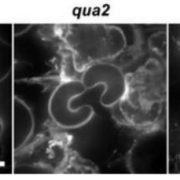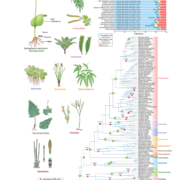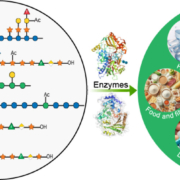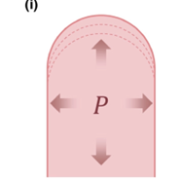Plant Cell Wall Composition: Does Ploidy Matter?
Most of the carbon dioxide sequestered by plants during photosynthesis is converted into sugars and stored into polysaccharide-enriched cells walls that constitute the majority of the plant biomass. While plants have long been considered a valuable resource of biomaterials for the chemical and textile industries, recent efforts have been directed toward the use of lignocellulosic materials as a feedstock for the sustainable production of second-generation biofuels (Carpita and McCann, 2008). These efforts have prioritized the search for plants with enhanced biomass yields and higher conversion efficiency of lignocellulose into sugars (saccharification; Himmel et al., 2007). However, the genetic manipulation of cell wall composition often has been challenging, resulting in severe alterations in plant growth and development (Kumar et al., 2016). New genetic strategies targeting cellulose synthase activity or key regulatory factors in lignin biosynthesis have proven to be more effective in modifying the composition of secondary cell walls, achieving superior saccharification efficiencies without compromising plant growth (Li et al., 2018; Xie et al., 2018).
Hybrids and polyploids often are associated with plant growth vigor, higher yields, and enhanced fitness (Comai, 2005). These characteristics have been widely used by plant breeders to improve biomass production in economically interesting species (Sattler et al., 2016). But do plants with higher ploidy levels always perform better? In particular, it is not well understood how increased ploidy levels affect the composition of the plant biomass. In this issue of Plant Physiology, Corneillie et al. (2018) conducted a series of kinematic, morphometric, and chemical analyses to assess how growth rates, biomass yield, and cell wall composition are affected in plants with increased ploidy levels (2n, 4n, 6n, and 8n) in Arabidopsis (Arabidopsis thaliana; Fig. 1). The authors show that plants with higher ploidy display a general increase in cell size, flowers, and seeds, a phenomenon that has been described as the Gigas effect (Knight and Beaulieu, 2008). However, increased ploidy in Arabidopsis comes with a fitness cost. Polyploids show an overall reduction in growth rates and delayed flowering. The increase in cell size is accompanied by a proportional reduction in cell proliferation, which significantly affects the vigor of hexaploid and octaploid plants. These detrimental effects are thought to result from a tradeoff between DNA nuclear volume/content and the cost of the cell cycle, usually referred to as the high-ploidy syndrome (Tsukaya, 2008). As a result, only tetraploids exhibit a significant increase in biomass yield, which was noticeably reverted in hexaploids and octaploids (Fig. 1). To further investigate the effects of plant growth, the authors analyzed cell wall structure and composition. Higher ploidy levels were associated with a proportional reduction in secondary cell wall deposition, lignin and cellulose content, which occurs with a compensatory increase in hemicelluloses, pectin, extensins, and arabinogalactan proteins. The observed reduction in lignin content and the parallel increase of other cell wall polysaccharides were associated with an increase in saccharification yield in higher polyploids.
Arabidopsis rosettes with increased ploidy levels. Variations in somatic ploidy levels are associated with increase in cell size and delayed development with an impact in biomass content (see figure).

Taken together, the results of Corneillie et al. (2018) show that Arabidopsis polyploids display substantial phenotypic variation with respect to growth characteristics and biomass accumulation. These results are consistent with an optimum balance for chromosome number, beyond which polyploid individuals become less vigorous. The findings of Corneillie et al. (2018) further indicate that the composition of cell walls in plants with higher ploidy levels present alterations that are seen as critical quality criteria for the production of biofuels. While Arabidopsis has been a powerful model system for plant cell wall research, finding mutants that affect cell wall features in polyploid species is certainly a challenge. Given that most of our current crops are natural or domesticated hybrids and polyploids, it is expected that the manipulation of ploidy levels can be explored further as a viable route to fulfill our needs for novel cultivars with improved biomass quality for renewable bioenergy production.
REFERENCES
Carpita NC, McCann MC (2008) Maize and sorghum: Genetic resources for bioenergy grasses. Trends Plant Sci 13: 415–420
Comai L (2005) The advantages and disadvantages of being polyploid. Nat Rev Genet 6: 836–846
Corneillie S, De Storme N, Van Acker R, Fangel JU, De Bruyne M, De Rycke RM, Geelen DNV, Willats WGT, Vanholme B, Boerjan WA (2018) Polyploidy affects plant growth and alters cell wall composition. Plant Physiol 10.1104/pp.18.00967
Himmel ME, Ding SY, Johnson DK, Adney WS, Nimlos MR, Brady JW, Foust TD (2007) Biomass recalcitrance: Engineering plants and enzymes for biofuels production. Science 315: 804–807
Knight CA, Beaulieu JM (2008) Genome size scaling through phenotype space. Ann Bot 101: 759–766
Kumar M, Campbell L, Turner S (2016) Secondary cell walls: Biosynthesis and manipulation. J Exp Bot 67: 515–531
Li F, Liu S, Xu H, Xu Q (2018) A novel FC17/CESA4 mutation causes increased biomass saccharification and lodging resistance by remodeling cell wall in rice. Biotechnol Biofuels 11: 298
Sattler MC, Carvalho CR, Clarindo WR (2016) The polyploidy and its key role in plant breeding. Planta 243: 281–296
Tsukaya H (2008) Controlling size in multicellular organs: Focus on the leaf. PLoS Biol 6: e174
Xie M, Zhang J, Tschaplinski TJ, Tuskan GA, Chen JG, Muchero W (2018) Regulation of lignin biosynthesis and its role in growth-defense tradeoffs. Front Plant Sci 9: 1427









